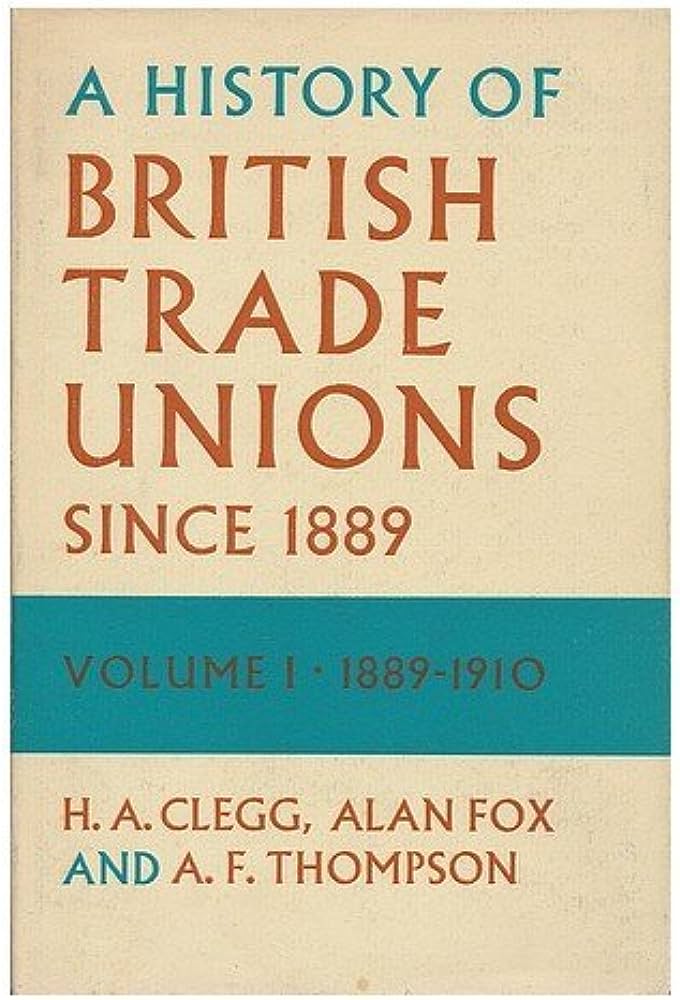Biblioteca / 1960-1969 1980-1989 1990-1999
Hugh Clegg – Alan Fox – Arthur Thompson. A History of British Trade Unions since 1889.
Oxford: Oxford University Press/Clarendon Press, 1964-1985-1994.
3 tomos: xi, 514+ix, 458+xiii, 619 páginas.
Contents
VOLUME I
1889-1910
PREFACE
1 – THE TRADE UNION MOVEMENT BEFORE 1889
Size and Distribution
The Craft Societies
Coal and Iron
Hosiery and Footwear
Cotton
Other Industries
Trade Unionism and Social Status
Union Government and Policy
The Law, Parliament, and Public Opinion
Trade Unions and Politics
2 – THE NEW UNIONISM AND THE FIRST COUNTER-ATTACK
1889
The Counter-attack begins
More Defeats, 1891-3
The Survivors, 1894-1900
The Nature of the New Unionism
3 – COAL AND COTTON
Dimensions
The Miners’ Federation
The Non-federated Areas
The 1893 Lock-out
Spinning Lock-outs and the Brooklands Agreement
The Weavers’ Uniform List
Industrial Peace, 1895-1900
The Organization of the Scottish and South Wales Coalfields
4 – THE CRAFT UNIONS AND THE GENERAL COUNTER-ATTACK
The Boom Years, 1889-91
Demarcation Disputes and Inter-union Conflict
Tailoring
Engineering
Printing and Shipbuilding
Building Craftsmen slip the Leash
Furniture
The Engineering Lock-out
The Nature of the Counter-attack
5 – PATTERNS OF INDUSTRIAL RELATIONS
Agriculture and Fishing
Wholesale Clothing
Wool and Minor Textiles
Industrial Collaboration
The Boot and Shoe Trade
Iron and Steel
The Penrhyn Dispute
6 – PARLIAMENTARY ACTION AND THE TRADES UNION CONGRESS
Government Employees
Teachers and Other White-collar Workers
Railwaymen
Coal and Cotton
The Trades Union Congress
7 – PARLIAMENTARY REPRESENTATION AND SOCIALISM
Parliamentary Representation
Local Representation and Trades Councils
Socialist Infiltration in the Unions
8 – THE LAW AND THE TAFF VALE JUDGEMENT
The Courts and the Unions, 1890-1900
The Taff Vale Judgement and its Effects
9 – COLLECTIVE BARGAINING UNDER TAFF VALE
The Effect of the Taff Vale Judgement on Strikes
Decline and Stagnation
Progress in Collective Bargaining
The Building Industry
The General Federation of Trade Unions
White-collar Unions and Public Employees
The Causes of Industrial Peace
10 – POLITICS, 1900-10
Parliamentary Activities, 1900-5
The Labour Representation Committee
The Election of 1906
Parliamentary Work, 1906-10
Politics Outside Parliament
The Osborne Judgement and the 1910 Elections
11 – MOUNTING INDUSTRIAL DISCONTENT, 1906-10
The Railway Conciliation Scheme
The Craft Societies in the Doldrums
Inter-union
Conflict Growth, Especially in Coal and Cotton
12 – GROWTH AND CHANGE, 1889-1910
Growth
Collective Bargaining and its Shortcomings
Trade Union Government
Comparative Wages and Earnings
Public Standing
The ‘Working-class Movement’
________
VOLUME II
1911-1933
PREFACE
1 – TRADE UNIONS IN 1910
Membership
Industrial Functions
Political Action
Finance
Government
Leaders and Ideas
2 – INDUSTRIAL UNREST, 1911-14
Causes of Unrest
The Cambrian Strike, 1910-11
Transport 1911
Lancashire Weavers, 1911-12
Coal, 1912
Dundee Jute and London Docks, 1912
London Cab Drivers and Midlands Metalworkers, 1913
Dublin, 1913-14
London Building Workers and Yorkshire Miners, 1914
Causes Reviewed
3 – COLLECTIVE BARGAINING, THE GOVERNMENT, AND UNION STRUCTURE
The Crafts, Coal, and Cotton
Other Industries and the Less-Skilled
Public and Private Services
The Government
Trade Union Structure
4 – ASQUITH’S WAR
The Impact of War
The Munitions of War Act, 1915
Dilution
Wages and Prices
Conscription, Exemption, and Manpower Shortages
5 – LLOYD GEORGE’S WAR
Lloyd George and the Unions
The May Strikes
Tensions within the Unions
Pay and Manpower, 1917-18
The Effects on the Unions
6 – PARTY POLITICS, 1911-18
The Prewar Years
Unity Maintained, 1914-17
The Reconstruction of the Party
The General Election of 1918
7 – RECONSTRUCTION AND DIRECT ACTION
Reconstruction
Collective Bargaining, 1919-20
Industrial Unrest and Its Causes
‘Direct Action’
Trade Unions at a Peak of Growth
8 – THE POSTWAR DEPRESSION
The Impact of the Depression
Pay Reductions
The Engineering Lockout
The Effects on the Unions
9 – THE FIRST LABOUR GOVERNMENT
The Unions and the Labour Party, 1918-23
The Communists and the Left
The First Labour Government
Industrial Disputes
The Aftermath
10 – THE GENERAL STRIKE
Industrial Relations, 1925
Red Friday
Autumn and Winter, 1925-6
Negotiations
The Strike
The Miners’ Lockout
Inquest and Aftermath
11 – INDUSTRIAL RELATIONS IN THE TWENTIES
Collective Bargaining under Stable Conditions
Industrial Relations at the Workplace
Inside the Unions
A New Philosophy
The Mond-Turner Talks
12 – THE SECOND LABOUR GOVERNMENT
The Unions and the Labour Party, 1925-9
The Government
Pay Cuts and Industrial Disputes
Unemployment
The Fall of the Government
13 – THE TURN OF THE TIDE
The National Government
Resisting Pay Cuts
Industrial Relations in the Depression
The Unions
14 – TRADE UNIONS IN 1933
Growth
Collective Bargaining
Government
Finance
Political Action
Public Standing
Wages and Welfare
The Future
Statistical Appendix
Biographies
Bibliography
________
VOLUME III
1934-1951
PREFACE
I – COLLECTIVE BARGAINING, 1934-1939
Engineering
Shipbuilding and Steel
Coalmining
Textiles and Clothing
Construction
Paper and Printing
The Railways
Other Transport
Other Private Industries
White-Collar Unions in Private Industry
Local-Government Services
Gas, Electricity, and Water Supply
The Civil Service
The Development of Collective Bargaining
2 – TRADE UNIONS IN THE LABOUR MOVEMENT, 1934-1939
Congress and the General Council
The Labour Party
The Labour Movement’s Foreign Policy
The Unions and the Left
3 – THE WAR
The ‘Phoney’ War
General Pay Movements 1940-1945
Special Pay Problems
Manpower
Joint Production Committees
Strikes, the Left, and the Law
Bevin as Minister of Labour and National Service
4 – WARTIME POLITICS AND POST-WAR PLANNING
The Labour Party at War
Post-war Plans
Trade Union Reconstruction
The General Election of 1945
5 – THE LABOUR GOVERNMENT, 1945-1951
The Unions after the War
The Government’s Record
Collective Bargaining 1945-1947: Hours of Work
Nationalization and Industrial Democracy
The Cold War and the World Federation of Trade Unions
Wage Policy
‘Severe Restraint’
The End of Wage Policy
Salaries under Wage Policy
The Fall of the Labour Government
6 – THE YEARS 1889-1951 IN RETROSPECT
Union Growth
Collective Bargaining
Union Structure
Union Government and the Work-place
Industrial Action
Political Action
Statistical Appendix
Trade Union Biographies
Bibliography


